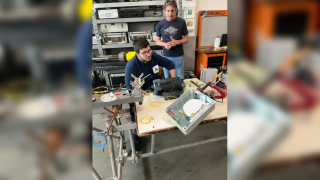Q: Can you briefly describe a working day for us?
A: My typical working day is fast paced and varied. I work in Ciena’s advanced electro-optics hardware development team, delivering high-speed electro-optics sub-systems into Ciena’s WaveLogic optical transponders which transport 40G, 100G, 200G and even up to 400G on a single wavelength. At any given time the team is working on two or three generations of hardware, designing new gear that will be released in the future. I typically spend a portion of my day in the lab performing measurements to characterise optical components and subsystems such as lasers, optical modulators, amplifiers and receivers; and another portion of the day designing, simulating and documenting our next-generation hardware. The work can range from developing basic mathematical models describing the physics of optical devices, to designing control algorithms for optical subsystems, to interacting with a range of other teams, manufacturing and test engineering.
Q: What are the most rewarding aspects of your job?
A: I’m continually challenged to learn new concepts and apply them to solve difficult problems. I’m fortunate to work with a top notch team of people who are experts in their subject matter.
Probably the most rewarding part of my job is seeing our finished product going out to the field and carrying data for our customers in their networks. Though I have a lot of background in the maths and physics that govern our systems, sometimes I find myself completely awestruck by what we’re doing. I had the privilege of being part of a field trial last year, seeing hardware that I helped to design installed in Ciena shelves, carrying many terabits of data in a customer’s backbone network. That was really rewarding.
Q: What are the most challenging aspects of your job?
A: I have to mentally be able to switch gears very quickly as I interact with other designers on a wide range of problems. One minute I might be working through equations describing the physics of an optical device, and the next minute discussing embedded firmware architecture for control algorithms.
Q: How might your role might evolve?
A: I’m lucky that my job challenges me to continually learn. In the next few years, we’ll be continuing to innovate new systems to transmit more bits per second using less optical spectrum, and requiring less power for lower cost. For me, this means expanding my knowledge of digital signal processing, modelling the physics of more complicated electro-optics components and developing increasingly sophisticated methods of characterising and controlling the hardware.




